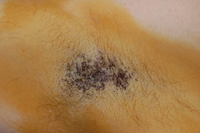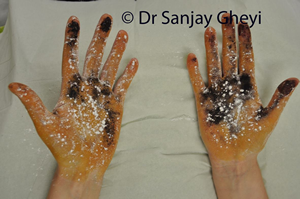Hyperhidrosis [excessive sweating] treatments
Please note that this section is information for botulinum toxin injections [ Botox®, Dysport®] only and does not constitute a treatment recommendation which should only be considered after a medical consultation

Active sweat glands appear darker on starch-iodine test


Reduction of sweating after treatment
If localised excessive sweating is significantly interfering with your daily activities and topical agents haven't worked, you may be a candidate for Botox® treatment. Excessive underarm sweating is a very common condition but often not recognized or treated. If you suffer from increased sweating, worry about sweating through your clothes, work in close contact with others or in hot conditions or have to make public presentations then you may consider treatment.
What is hyperhidrosis?
Hyperhidrosis means excessive sweating. It can be localised or affect the whole body. Sweat is your body's temperature regulator. Severe underarm sweating is usually due to overactive sweat glands. In severe primary axillary hyperhidrosis, sweating significantly exceeds the body's normal requirements for cooling. Sometimes excessive sweating is due to other medical causes and here treatment is directed towards the underlying cause. In this case sweating is usually generalised.
Generalised hyperhidrosis (affecting the whole body) can be caused by some medications, illnesses including chronic infections, some cancers and by some hormonal conditions including the menopause, diabetes and an overactive thyroid gland. Sometimes no cause can be found. Anxiety, depression and stress can trigger or worsen hyperhidrosis.
How do I know if there is underlying problem?
Usually symptoms of the underlying cause are present so if you are generally healthy chances are that you have primary hyperhidrosis. Some more pointers towards this are-
Onset in young age, involvement on both sides and cessation of sweating during sleep. Diagnosis is usually made on clinical picture but sometimes further testing is necessary.
What are the treatment options ?
When there is an underlying cause which can be treated, the hyperhidrosis can be cured. Surgical treatment can cure some people. Otherwise the aim is to control the condition.
You can take some general measures such as daily showering, wearing loose cloths made of natural fibre and frequent change of clothing etc. Usual first line is anti-perspirents which you can buy over the counter. There are some stronger antiperspirants such as aluminum chloride hexahydrate, driclor or anhydrol Forte. Treatment consists of applying the medication onto the skin and leaving it on overnight and washing off again in the morning. The skin must be dry and clean upon application. Follow precautions as suggested by manufacturers. If sweating affects hands or feet there are treatment options such as medications and iontophoresis.
If localised sweating is significantly interfering with your daily activities and anti-perspirants have not worked, you may be a candidate for Botulinum toxin type A [ botox or dysport ] treatment. This treatment is not recommended for generalised sweating.
What is Botulinum toxin A ?
Botulinum toxin, otherwise know as botox or dysport is a treatment given by injection into the skin. This drug has been used for many years to treat muscle spasms affecting the face, eyes and neck and for foot problems in children with cerebral palsy. It is also used for cosmetic purposes. The procedure is mostly done in private clinics due to very limited availability on the NHS.
Botox helps control this condition by temporarily blocking the chemical signals from the nerves that stimulate the sweat glands. When the sweat glands don't receive chemical signals, the severe sweating stops.
Botox is not suitable for those who are allergic to any of its contents or for those who are pregnant or breast feeding. Those on certain antibiotics or any drugs used as muscle relaxants should also not have treatment. The effect of this treatment can last from 6-12 months.
What areas can you treat ?
Botulinum toxin treatment is not suitable for generalised sweating. If you suffer from excessive sweating only from a limited area then you can benefit from this treatment. Commonly used areas are the underarms but we also use it for hands, feet, scalp, face and neck areas.
Side Effects ?
Although generally this treatment is very successful for the underarms and without significant side effects, rarely patients can experience an increase in sweating in another part of the body. Very rarely a small amount of Botox may spread out from the injection site and affect a nearby nerve that supplies the muscle causing temporary weakness of the surrounding muscles. The injection site can also be a bit sore for 2-3 days.
Before treatment, it will be necessary to remove the hair in your armpit by shaving or by using hair removing cream. Do not use any deodorants or antiperspirants for 24 hours before treatment.
Please do not wear expensive shirt on the day of treatment as iodine can stain it.
Most patients will obtain the benefit of dryness with one treatment of Dysport® for up to one year.
Cost
Cost of treatment is from £ 350 for the face and from £ 550 for hands or feet or for both underarm injections
Do you offer a long term solution for underarm sweating ?
Yes, we offer laser assisted sweat gland treatment. This is a minimally invasive option performed under local anaesthesia. A solution of medications is injected just below the skin. Then a hair thin laser fibre is introduced. The laser is then activated to destroy the sweat glands. See under laser treatments section


